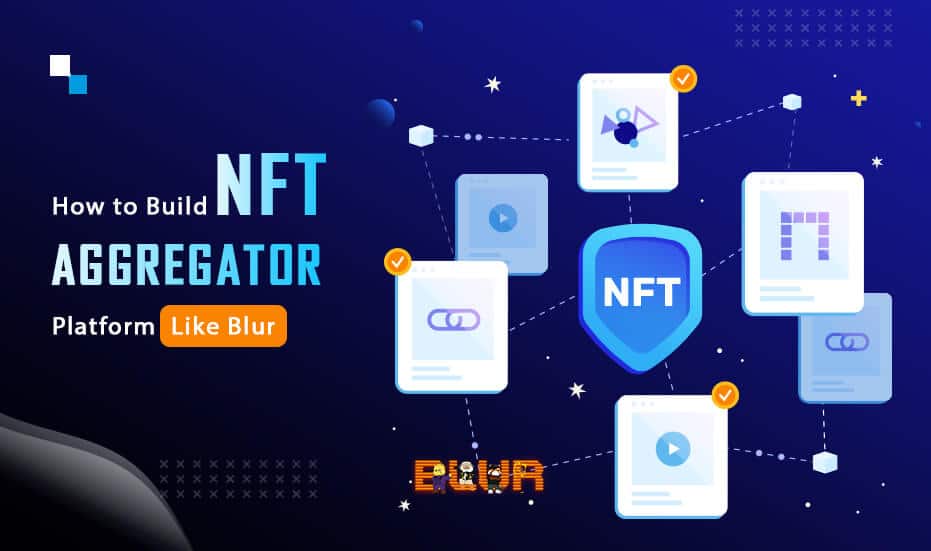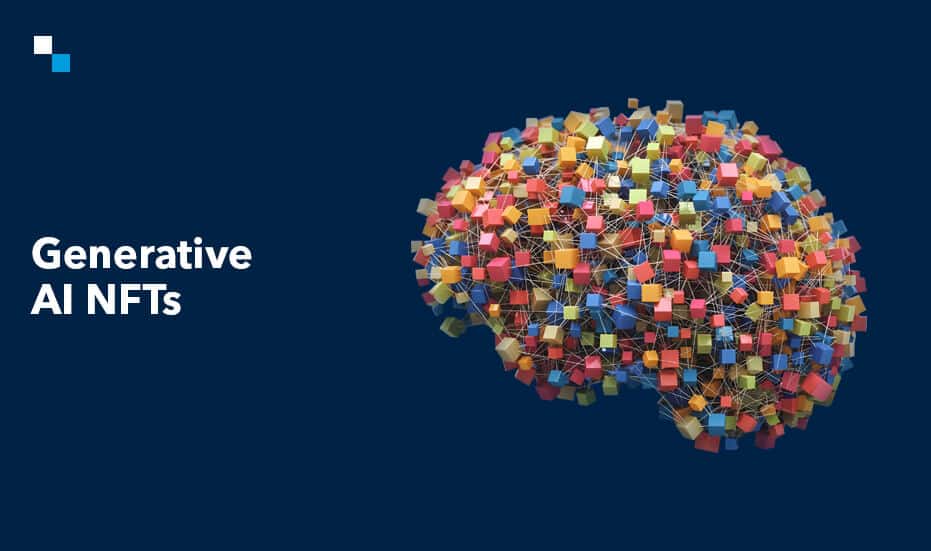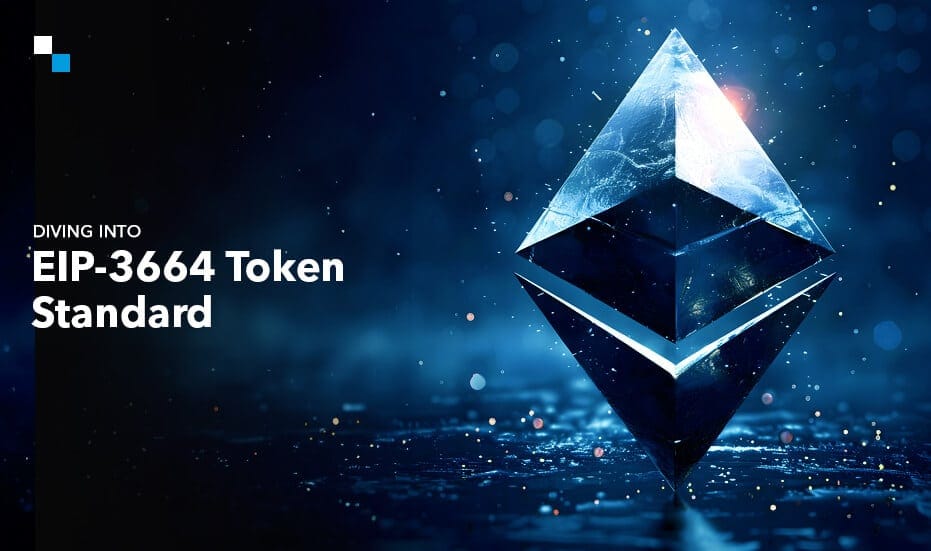
Exploring Polygon Edge: The Future of Blockchain Development
May 23, 2023
All You Need To Know Before Developing Your P2P Exchange in 2023
May 23, 2023The NFT market has witnessed explosive growth and diversification, leading to a proliferation of NFT marketplaces and blockchain networks across the globe.
Non-Fungible Tokens (NFTs) have emerged as a transformative force in the digital landscape, showcasing their remarkable importance.
NFT marketplace development has empowered content creators with new revenue streams and provided them with unparalleled control over their intellectual property. Moreover, NFTs have extended beyond art, permeating domains like gaming, collectibles, and virtual real estate, fostering vibrant and decentralized ecosystems.
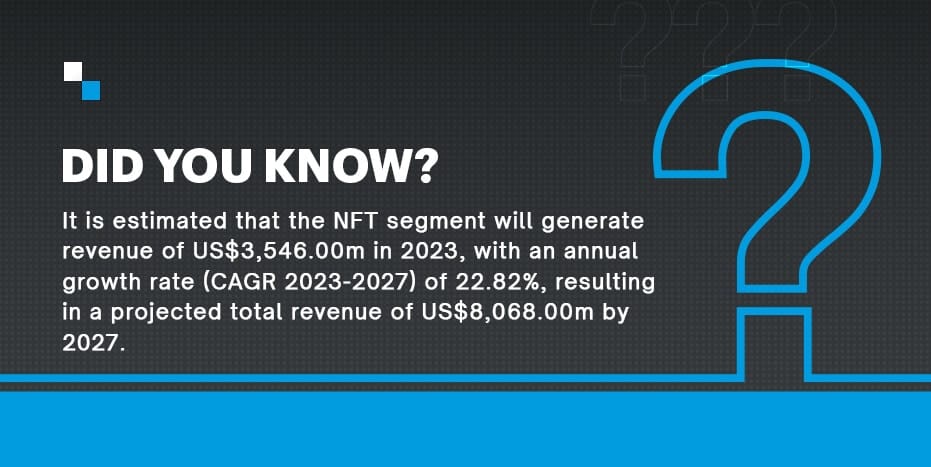
As the NFT space continues to evolve, NFT aggregators have gained immense importance lately, playing a pivotal role in the ecosystem’s growth and accessibility. These platforms serve as comprehensive hubs that curate, organize, and provide users with a streamlined experience for discovering and trading NFTs from various marketplaces and collections.
Table of Contents
- What is an NFT Aggregator?
- Why NFT Aggregators are Gaining Popularity
- Core Features of an NFT Aggregator
- Blur- An Emerging Concept in NFT Aggregator Space
- Key Highlights of Blur
- The Hype of Blur Clone Development
- Popular NFT aggregators
- How to Build an NFT Aggregator Like Blur?
- How to Use Blur Clone Script for NFT Aggregator Development?
- Technology Stack to Create a Successful NFT Aggregator Marketplace
- Future of NFT Aggregator Platform Development
What is an NFT Aggregator?
NFT aggregators are platforms or services that gather and curate NFTs from various marketplaces, allowing users to discover, explore, and track NFTs from multiple sources in a centralized location.
NFT aggregators have gained popularity due to their ability to simplify NFT discovery, enhance market transparency, and provide a unified experience for collectors, investors, and enthusiasts. NFT aggregators emerged to address the challenges of fragmentation and information overload.
These aggregators provide a convenient and efficient way for users to browse, search, and monitor the rapidly expanding NFT market. They play a crucial role in simplifying the NFT experience and addressing the challenges posed by the fragmented nature of the NFT marketplace development ecosystem.
Why NFT Aggregators are Gaining Popularity
NFT aggregators are becoming increasingly important in the NFT ecosystem by offering centralized platforms that streamline NFT discovery, enhance market transparency, and increase accessibility. Their growing popularity is a testament to the value they bring to users in navigating the expanding world of NFTs.
Key Highlights of NFT Aggregators:
- NFT aggregators act as centralized hubs that collect and present NFTs from different marketplaces and blockchain networks.
- They offer features such as search filters, sorting options, and customizable notifications to help users find NFTs based on their preferences.
- Aggregators typically provide additional information about the NFTs, such as ownership history, transaction records, and current market prices.
- NFT aggregators simplify the process of discovering and exploring NFTs by consolidating them into a single platform. Users can browse through various collections and marketplaces without the need to visit each platform individually.
- Aggregators provide valuable information about NFTs, including historical data, pricing trends, and trading volumes. This transparency enables users to make informed decisions and assess the market dynamics more effectively.
- NFT aggregators bridge the gap between different blockchain networks and marketplaces, allowing users to access a wider range of NFT marketplace development options. This accessibility expands the reach and user base of NFTs, benefiting both collectors and creators.
- Instead of manually tracking NFTs across multiple platforms, aggregators provide consolidated monitoring and alert features. Users can set notifications for specific NFTs or artists, simplifying the process of staying up-to-date with new releases and market developments.
Core Features of an NFT Aggregator
The global adoption of NFT aggregators has been significant and they have gained increasing importance within the NFT ecosystem.
When developing an NFT aggregator, there are several technical and must-have features that can enhance the platform’s functionality and user experience. While specific features may vary between different aggregators, here are some common core features:
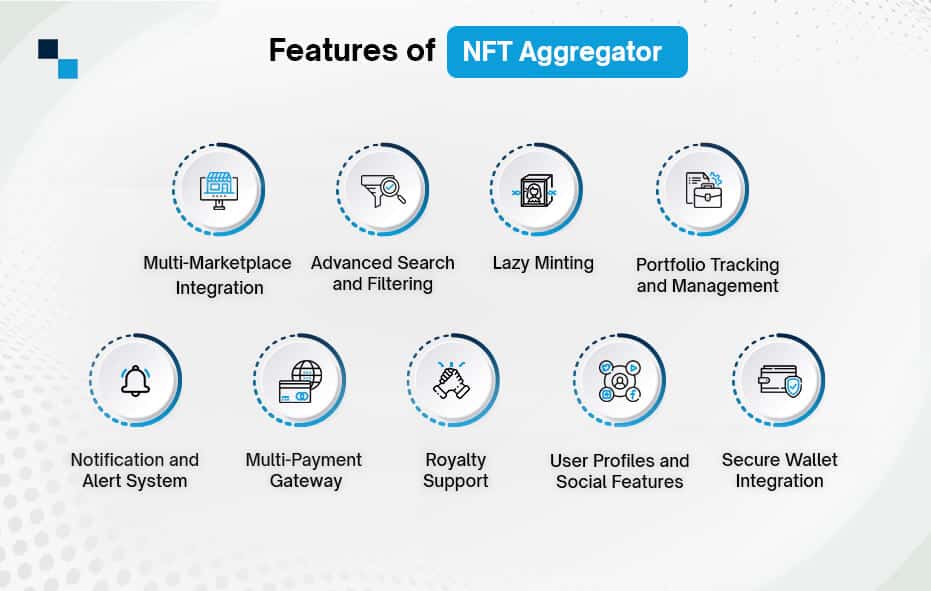
1. Multi-Marketplace Integration
Support for integrating multiple NFT marketplaces and blockchain networks to provide a wide range of NFT collections for users to explore. Seamless integration with popular marketplaces like OpenSea, Rarible, SuperRare, and more.
2. Advanced Search and Filtering
Robust search functionality allows users to search and filter NFTs based on various criteria such as category, artist, collection, price range, and attributes. Advanced filtering options like sorting by popularity, newly listed, trending, and recently sold.
3. Lazy Minting
Lazy minting allows aggregators to display NFT metadata and images without actually minting them on-chain until the moment of purchase, saving gas fees and improving scalability.
4. Portfolio Tracking and Management
User-friendly portfolio management tools that enable users to track their owned NFTs, view their current value, and monitor their performance in real time. Portfolio analytics and visualizations, including historical price charts and ROI calculations.
5. Notification and Alert System
Customizable alerts and notifications for users to stay updated on new releases, price changes, bids, and other activities related to their tracked NFTs or favorite artists/collections.
6. Multi-Payment Gateway
Integration with multiple payment gateways to support various cryptocurrencies and fiat currencies for seamless buying and selling of NFTs. Options to accept popular cryptocurrencies like Ether (ETH), stablecoins, and potentially other blockchain-native tokens.
7. Royalty Support
Ability to handle and enforce royalties for creators on secondary sales, ensuring that creators receive a percentage of subsequent transactions involving their NFTs.
8. User Profiles and Social Features
User registration and personalized profiles to showcase owned NFTs, collections, and transaction history. Social features like comments, likes, shares, and following capabilities foster engagement and community interaction.
9. Secure Wallet Integration
Integration with secure wallets (e.g., MetaMask) to enable users to connect their wallets, manage their NFTs, and execute transactions securely.
It’s worth noting that the NFT aggregator landscape is continually evolving, and new features may emerge over time based on user needs and market trends. Moreover, specific features and requirements of an NFT aggregator may vary depending on the target audience, business goals, and technological considerations.
Different aggregators may prioritize certain features or offer additional functionalities beyond the core ones mentioned above.
Blur- An Emerging Concept in NFT Aggregator Space
Blur is an important feature in the NFT aggregator space as it helps protect user privacy and provides a layer of anonymity. It plays a vital role in the NFT aggregator space by safeguarding user privacy, enhancing security, and empowering users with control over their information.
By implementing blur NFT functionality, aggregators can create a more secure and user-centric experience, fostering trust and attracting a wider user base.
Let’s take a quick glance at the volume and trades of Blur and other popular NFT marketplaces so far:

Key Highlights of Blur

- Privacy Protection: NFT Blur functionality allows users to protect their personal information and NFT holdings from being easily identifiable or associated with their real-world identities. It adds a layer of privacy and shields users from potential risks, such as targeted attacks or unwanted attention.
- Security Enhancement: By obscuring specific details of NFT ownership or transaction history, NFT blur helps mitigate potential security vulnerabilities. It reduces the risk of malicious actors targeting high-value NFT holders or attempting fraudulent activities based on publicly available information.
- Anti-Scraping Measures: Blur can make it more challenging for data scrapers and bots to gather comprehensive information about users’ NFT collections. This can discourage automated scraping techniques used by unethical individuals or organizations for data mining or competitive purposes.
- Anti-Front Running: Front running is a practice where someone gains advanced knowledge of pending transactions and exploits it for personal gain. Blur can prevent or limit the effectiveness of front-running strategies by obfuscating specific details, making it more difficult for opportunistic actors to take advantage of others’ transactions.
- User Empowerment: By incorporating blur functionality, NFT aggregators give users more control over their online presence and information. Users can choose to reveal or conceal specific details according to their preferences, maintaining a level of autonomy in the NFT ecosystem.
- Enhanced User Experience: Blur features provide peace of mind to users, promoting a sense of security and trust in the NFT aggregator platform. This can lead to increased user engagement, retention, and a positive reputation for the aggregator in the market.
The Hype of Blur Clone Development
With increasing online activities and data breaches, there is a heightened awareness of the importance of privacy protection. Users are more conscious of their online presence and seek ways to safeguard their personal information. Blur clones provide individuals with the ability to obscure their details, offering an added layer of privacy and control over their digital identity.
Blur clone development enables users to protect their sensitive information, such as email addresses, credit card details, and browsing history, from being exposed to potential security threats.
Let’s explore other compelling reasons why Blur clone development is being adopted at a global level.
- Increased Awareness of Online Privacy: The general public’s awareness of online privacy concerns has grown significantly in recent years. High-profile data scandals and the introduction of privacy regulations, such as the GDPR and CCPA, have raised awareness about the importance of protecting personal information. As a result, individuals are actively seeking solutions like Blur clones to regain control over their online privacy.
- Rise of Digital Identity Protection: The concept of digital identity protection is gaining traction as individuals recognize the need to safeguard their online personas. Blur clones offer an effective way to protect digital identities by allowing users to mask or modify personal details, making it more challenging for unauthorized parties to exploit or misuse their information.
- User Empowerment: Blur clone development puts the power back in the hands of users, allowing them to take control of their online presence and decide which information they want to share. This sense of empowerment resonates with individuals seeking more agency over their personal data and online interactions.
Popular NFT aggregators
Here is the list of popular NFT aggregators currently available in the market
OpenSea Pro
OpenSea Pro stands out as the best NFT aggregator, offering unparalleled features and a vast selection of NFTs from various NFT marketplace development options. With its robust platform, seamless user experience, and extensive market reach, OpenSea Pro is the go-to choice for collectors, artists, and enthusiasts in the NFT space.
Rarity.tools
Rarity.tools provides a comprehensive NFT aggregator that offers tools and analytics for various NFT collections. It allows users to track and compare rarity traits, prices, and other data across multiple projects.
NFTX
NFTX is an NFT aggregator and decentralized exchange that focuses on creating and trading index funds of NFTs. Users can invest in collections of NFTs representing different themes or categories.
Rarity Sniper
Rarity Sniper is an NFT aggregator that focuses on tracking and analyzing rarity traits of NFT collections. It helps users identify valuable and unique NFTs based on rarity scores and other metrics.
NFTBank.ai
NFTBank.ai is an NFT aggregator that provides users with tools for NFT portfolio management and analytics. It offers features like tracking NFT prices, monitoring wallet holdings, and generating performance reports.
How to Build an NFT Aggregator Like Blur?
Building an NFT aggregator like Blur requires careful planning, technical expertise, and a solid understanding of the NFT ecosystem. An NFT aggregator acts as a platform that brings together various NFT marketplaces, allowing users to discover and trade NFTs from different sources. Blur NFT aims to provide a seamless and unified experience for NFT enthusiasts.
Steps to Build NFT Aggregator Platform Like Blur
Here are the important steps to develop an NFT aggregator like Blur:
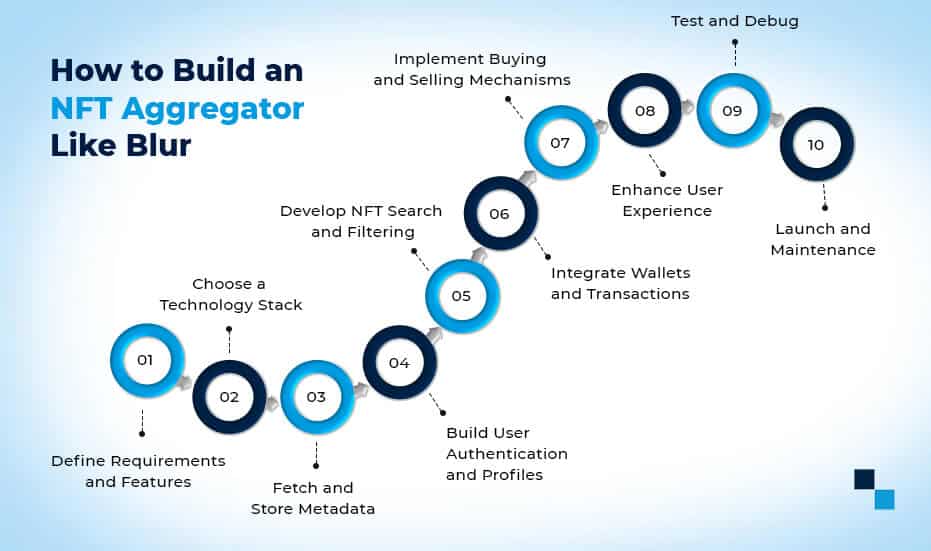
1. Define Requirements and Features:
Identify the key features you want to offer, such as NFT discovery, search filters, collections browsing, user profiles, and integrated wallets. Determine the scope of your aggregator and the marketplaces you want to support.
2. Choose a Technology Stack:
Select the appropriate technology stack based on your requirements. Common choices include backend frameworks like Node.js or Django, frontend frameworks like React or Angular, and a database like PostgreSQL or MongoDB.
3. Fetch and Store Metadata:
Retrieve NFT metadata from supported marketplaces using their APIs. Store the metadata in your database, including attributes like image URLs, descriptions, owner details, and pricing information. Regularly update the metadata to ensure accuracy.
4. Build User Authentication and Profiles:
Implement user authentication and authorization mechanisms. Enable users to make new accounts, log in, and easily manage their profiles. This includes features like saved collections, favorited NFTs, and transaction histories.

5. Develop NFT Search and Filtering:
Create search functionality to allow users to discover NFTs based on various criteria like name, collection, artist, and tags. Implement filtering options to refine search results based on attributes like price range, ownership, and rarity.
6. Integrate Wallets and Transactions:
Integrate with popular cryptocurrency wallets like MetaMask or WalletConnect to enable seamless transactions. Allow users to connect their wallets, view their NFT holdings, and execute buying/selling actions securely.
7. Implement Buying and Selling Mechanisms:
Facilitate NFT buying and selling by connecting with the respective marketplaces’ APIs. Enable users to create listings, place bids, and execute transactions seamlessly. Handle transaction fees and ensure secure escrow mechanisms.
8. Enhance User Experience:
Focus on creating an intuitive and user-friendly interface. Optimize performance, implement responsive design, and provide smooth navigation. Consider adding features like notifications, activity feeds, and social sharing to enhance user engagement.
9. Test and Debug:
Thoroughly test your aggregator’s functionality, security, and performance. Conduct both manual and automated testing to ensure a bug-free experience. Consider conducting a public beta test to gather feedback and make necessary improvements.
10. Launch and Maintenance:
Deploy your NFT aggregator to a production environment. Monitor user feedback and continuously improve the platform based on user needs and market trends. Stay updated with blockchain developments and integrate new marketplaces or features as the NFT ecosystem evolves.
To start an NFT aggregator platform like Blur, one needs to focus on a combination of technical expertise, robust backend infrastructure, seamless integration with marketplaces, and a user-centric approach.
By following these steps, you can create a feature-rich NFT aggregator that provides users with a unified and streamlined experience, empowering them to explore and trade NFTs from various sources. Continuously evolve your aggregator based on user feedback and market trends to stay at the forefront of the rapidly growing NFT industry.
How to Use Blur Clone Script for NFT Aggregator Development?
A Blur clone script plays a crucial role in the development of an NFT aggregator like Blur. It serves as a ready-made solution that encapsulates the core functionalities and features of Blur, allowing developers to fast-track the development process. With a Blur clone script, developers can save valuable time and effort by leveraging pre-built components, modules, and integrations.
It provides a solid foundation for building Blur clone script, including essential features like NFT metadata retrieval, API integrations with various marketplaces, user authentication, search and filtering options, and transaction management. By utilizing a Blur clone script, developers can focus on customization, scalability, and fine-tuning the aggregator to meet specific requirements, while benefiting from the proven architecture and functionality of Blur.
Using a Blur clone script for NFT aggregator development is a straightforward process that can significantly accelerate the development timeline. First, acquire the Blur clone script from a trusted provider. Then, customize the script to align with your specific branding, design, and feature requirements. This involves configuring marketplace integrations, API connections, and user authentication mechanisms.
Additionally, modify the UI/UX elements to create a unique user interface. Once customization is complete, thoroughly test the aggregator to ensure its functionality, security, and performance. Finally, deploy the aggregator to a production environment and monitor its performance. Leveraging a Blur clone script streamlines the development process, enabling you to create a feature-rich Blur clone app efficiently while reducing development costs and time to market.
Technology Stack to Create a Successful NFT Aggregator Marketplace
Prior to the development phase, one needs a detailed understanding of the technology stack for both the backend and frontend components to build an NFT aggregator platform like Blur successfully.
Backend Technology Stack
- Programming Language: Choose a programming language that is suitable for web development. Common choices include Python, JavaScript (Node.js), Ruby, or Go.
- Web Framework: Select a web framework that simplifies backend development and provides essential features. For JavaScript, popular frameworks include Express.js, Koa.js, or Nest.js. Python developers often use frameworks like Django or Flask.
- Database: Decide on a database to store NFT metadata and user-related information. Options include SQL databases like PostgreSQL or MySQL, or NoSQL databases like MongoDB or Redis.
- API Integration: Utilize APIs provided by various NFT marketplaces to fetch metadata, transaction details, and user information. Use tools like Axios or Requests to make HTTP requests and interact with the APIs.
- Authentication and Authorization: Implement user authentication and authorization mechanisms to secure user accounts and ensure access control. Libraries like Passport.js or JWT (JSON Web Tokens) can be used for authentication.
- Data Storage and Caching: Employ efficient data storage and caching mechanisms to optimize performance. Use technologies like AWS S3 for storing images and caching solutions like Redis to cache frequently accessed data.
- Blockchain Integration: Integrate with blockchain networks to retrieve NFT ownership information and transaction data. For example, utilize Ethereum APIs like Web3.js or libraries such as ethers.js for interacting with the Ethereum blockchain.
Frontend Technology Stack
- HTML, CSS, JavaScript: These three fundamental web technologies form the basis of frontend development. HTML is used for creating the structure of web pages, CSS for styling and layout, and JavaScript for interactivity and dynamic functionality.
- Frontend Framework: Consider using a frontend framework to simplify development and enhance productivity. Popular choices include React, Angular, or Vue.js. These frameworks provide component-based architecture, state management, and efficient rendering.
- UI/UX Libraries: Utilize UI libraries like Bootstrap, Material-UI, or Tailwind CSS to streamline the development process and ensure a visually appealing and responsive user interface.
- API Consumption: Connect the frontend to the backend APIs using technologies like Axios or Fetch API to send requests and retrieve data from the server.
- State Management: Employ state management libraries like Redux, MobX, or Vuex to manage application state and facilitate efficient data flow between components.
- Responsive Design: Implement responsive design techniques to ensure optimal user experience across different devices and screen sizes. CSS frameworks like Bootstrap or Flexbox/Grid systems can help achieve responsiveness.
- Testing and Debugging: Utilize testing frameworks like Jest or Cypress to perform unit tests, integration tests, and end-to-end tests for frontend components and functionality.
By leveraging a robust backend technology stack and a modern frontend technology stack, you can create a powerful and scalable NFT aggregator like Blur that delivers a seamless user experience and efficiently integrates with various NFT marketplaces.
Future of NFT Aggregator Platform Development
The future of NFT aggregators is promising, driven by advancements in blockchain technology, user-centric design, and expanding ecosystems. As the NFT market continues to mature, aggregators will play a vital role in facilitating seamless access, discovery, and trading of a diverse range of digital assets while continuously innovating to meet the evolving needs of users and the broader NFT community.
With the growing concern about the environmental impact of blockchain technology, NFT aggregators will increasingly emphasize sustainability. They will explore eco-friendly blockchain alternatives and promote energy-efficient practices to reduce carbon footprints associated with NFT transactions.
NFT aggregators may explore fractional ownership models, allowing users to purchase fractions of high-value NFTs. Tokenization of real-world assets, such as art, real estate, or intellectual property, could also become a significant aspect of NFT aggregators, expanding the potential use cases and value proposition.
You can always look for a professional NFT aggregator marketplace development company that can help you create a successful NFT aggregator marketplace from scratch while taking your NFT journey to new heights. Antier can be your ideal partner to accelerate your NFT business. Discuss your needs with our subject matter experts now.
